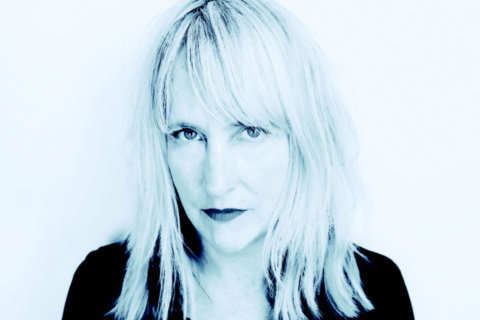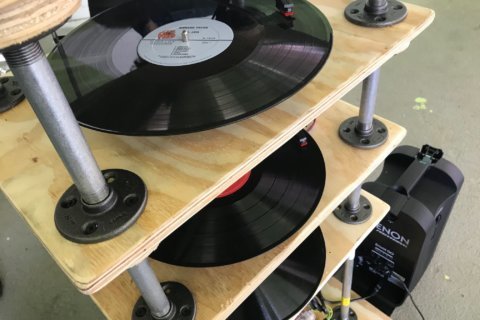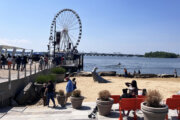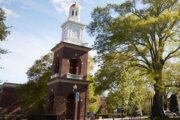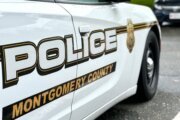WASHINGTON — This week marks 30 years since the public got its first view of a photo-heavy book depicting the earliest days of D.C.’s hardcore punk scene — and its author says the anniversary is both rewarding and disappointing.
Cynthia Connolly, Leslie Clague, and Sharon Cheslow got the first copies of their book, “Banned In DC: Photos and Anecdotes from the DC Punk Underground (79-85)” during the weeks before Christmas, 1988. The book collects hundreds of photos, flyers, and stories documenting the early days of the Washington scene.
This Thursday, in a talk and book signing at the Smithsonian’s Hirshhorn Museum, Connolly will reflect on the lessons learned in releasing seven editions over three decades.
“December 13, 1988, is exactly the date that I drove to the printer in Landover, Maryland, and picked up a handful of ‘Banned In DC’ books before they delivered them to my home,” Connolly told WTOP. “I drove through the city and dropped off one book at The Washington Post, late at night.”
Connolly didn’t have to wait long for the book to be noticed.
“The next morning, surprisingly, there was a review of the book by (music and arts critic) Richard Harrington,” she said.
Connolly and colleagues learned a valuable lesson in their do-it-yourself release.
“I didn’t realize that you needed to mark up the prices of books so that you could give a 40 to 60 percent discount to distributors and book and record stores,” said Connolly. “The cover price was $12, which was almost the cost of making each book.”
So, decades before online shopping for holiday gifts became an option, Connolly took a hands-on approach in the distribution of the book.
“I drove around a lot, selling them at shows, so that I could make as much money back as possible between December 13 and December 25,” she said.
With the too-low-price on the cover, Connolly and colleagues never sold the first edition to distributors, but the initial run of (she believes) 1500 copies were quickly sold locally, and by word of mouth.
Connolly, her sister Anna (who recently released her first album), and their mother had moved to Washington from Los Angeles in 1981, and quickly became fixtures in the “Georgetown Punks” scene, which bloomed into the hardcore punk scene, anchored by Dischord Records.
After attending the Corcoran School of Art from 1981 through 1985, Cynthia moved to San Francisco, to work on the Maximum Rocknroll zine, which at the time had thousands of subscribers.
While working in the Bay Area, and learning about photo layout and publishing, Connolly got her first inkling of putting out a photo book.
“It dawned on me in 1986 that a lot of people were moving away [from Washington] and going to college [elsewhere], and that a lot of the stories that I remembered from 1981, when I moved there from Los Angeles, might sort of disappear,” Connolly said.
Connolly moved back from San Francisco in summer 1986 and asked Clague to collaborate with her, since Clague had taken pictures of shows and made handmade books, Connolly said.
“I knew she had an understanding of how to make a book,” she said.
Despite the early popularity of the book, Connolly — like a lot of musicians — didn’t reap many financial benefits with the first edition.
“After selling them all, I was still in the hole, and it wasn’t until the second edition that I got out of the hole,” said Connolly. “Honestly, it was a labor of love, for sure.”
The second edition of the book includes some spelling corrections, but editions two through six remained largely unchanged.
“By the sixth edition, the printer said there was no way to make another book, because the negatives were now almost 20 years old and they were corroded,” said Connolly. “So, with the printing of the sixth edition I had announced this was the last edition, and it was going to go out of print.”
However, like countless bands that announced they were embarking on final tours, continued demand for the book — and new technology — made it possible for Connolly to print new, high-quality editions of “Banned In DC.”
“By this time, Photoshop was our friend,” smiled Connolly, saying many of the images in the seventh edition were digital scans of original photographs or from previous editions of the book.
“A lot of [contributing photographers] didn’t have their photographs, but also knew full well, with this kind of printing, scanning out of the book would be just fine,” Connolly said.
The seventh edition of the book, released in 2015, included an eight-page Afterward.
“I felt as though a lot changed in the 30 years since the book came out,” Connolly said. “The internet happened, distribution networks changed constantly, so every time a new edition came out I had to figure out ways to distribute it.”
Connolly said she was surprised to have issued seven editions of the book.
“I really thought it was going to be two editions possibly and then there would be no more demand for it,” she said.
In analyzing why her book remains in demand, Connolly said it has likely benefited by the release of other books about the scene.
“And, also some of the record labels continue to have their back catalog printed — like Dischord Records — the story of that punk scene continues, and has the back catalog to support that story. It hasn’t disappeared,” Connolly said.
Connolly, who booked bands at the former venue d.c. space, created the black sheep logo on the cover of Minor Threat’s 1983 album “Out of Step,” released on Dischord.
The images of the book aren’t the only aspect that hearken to 1988, Connolly said, referring to the Afterward of the seventh edition, which was written during the run-up to the 2016 presidential election.
“I was really glad to write this, because I had forgotten about it. I had approached 15 printers to get a [price quote for the original] and many of the printers refused to even give me a quote, or after they found out it was about punk music, they refused to print the book,” she said.
“It reminded me of how different it was in the 80s, during the Reagan era, and how as the decade progressed, you felt more and more threatened by your lifestyle being not acceptable in society,” said Connolly. “Now that Trump has been elected, right now I feel just as uncomfortable, if not more, about the choices I make in my lifestyle than I did in the 80s.”
In her upcoming talk at the Hirshhorn, Connolly said she will likely touch on how the “do it yourself” ethos of D.C.’s punk scene remains strong.
“Punk provided the idea of possibility, and the empowerment it gave to us to create, [even] outside of the realm of punk music,” said Connolly. “After the presentation, it’ll be interesting to meet people and hear their stories about how it affected their lives in a positive way.”


